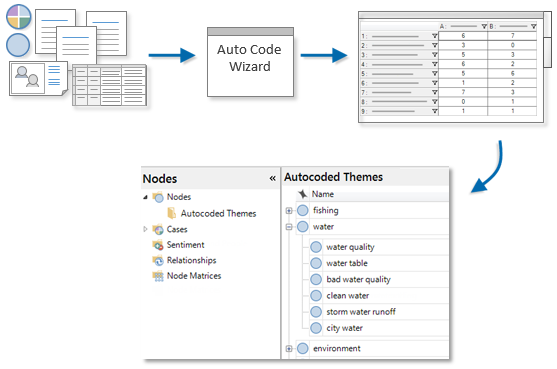
You might want to create nodes to represent people, organizations or other 'cases'. Top of Page Creating nodes for people, places and other entities Refer to About coding (Auto coding structured content) for more information. You can then open these nodes and explore what people have said in response to a particular question, 'coding on' to create more nodes as your themes emerge. For example, you could gather all responses to a particular interview question at a node. If you have tightly structured source materials, then you can use NVivo's 'auto coding' features to do 'broad brush coding'.
#Nvivo code code
For example, you could run a Text Search query to find all references to development and automatically code this content at a new node. You can also use queries to find and code content that relates to a particular theme at a new node. Refer to Create nodes manually for more information about creating nodes as you explore your sources, including 'in vivo' coding, At first, you might create nodes at the top level and then organize them into hierarchies when connections become apparent. You might want to work 'up' from your sources, creating nodes as you go.

Refer to Create nodes manually for more information about setting up node structures in List View. Top of Page Creating nodes for the themes in your source materialsĭo you already know which themes or topics you will be exploring? You can create a node structure before you begin coding, and easily add any nodes that emerge as you work through your sources. NOTE You cannot create your own subfolders within the Relationships and Matrices folders. You can use folders to set the scope of a query-for example, run a Text Search query on all the material in the Survey questions and responses folder. Just like sources, you can organize nodes in folders to suit the way you work: Top of Page Organizing nodes into folders When you open a node that has aggregation turned on, you can see all content coded at the node and content coded at the direct child nodes.įor more information, refer to Aggregate nodes (gather all content in a parent node). This column is not visible by default-you can add the column to your node List View. The icon in the Aggregate column indicates that aggregation is turned on.

For example, you could analyze how each town is adapting to climate change or turn on aggregation for the node Adaptation to climate change and see how all towns are adapting: When working with nodes in a hierarchy, you can gather all the material in child nodes and roll it up into the parent node. Top of Page Aggregating nodes (gather all content in the parent node) If there is no logical connection between your nodes (or perhaps these connections are not yet apparent) you can just add nodes at the top level of the hierarchy: You can organize these nodes in hierarchies-moving from general topics at the top (the parent node) to more specific topics (child nodes) Nodes are containers for your themes, people, places, organizations or other areas of interest. Refer to About node matrices for more information. You cannot code at the nodes in a node matrix. You create node matrices by querying your data using Matrix Coding queries.

Node Matrices are cross-tabulations of nodes that shows how the contents of different nodes relate to each other. Refer to About relationships for more information. For example, you could create a relationship node to record the relationship between two of the case nodes in your project (perhaps two people are married to each other). Relationships are nodes that define the connection between two project items. In Navigation View, under Nodes, there are folders for nodes, relationships and matrices-relationships and matrices are special types of nodes. Then when you open the node (by double-clicking it in List View) you can see all the references in one place. You gather the references by 'coding' sources such as interviews, focus groups, articles or survey results.įor example, while exploring your sources (documents, datasets, pictures, video or audio) you could code any content related to 'illegal fishing practices' at the node illegal fishing. Creating relationships and node matricesĪ node is a collection of references about a specific theme, place, person or other area of interest.Creating nodes for people, places and other entities.Creating nodes for the themes in your source materials.Aggregating nodes (gather all content in the parent node).


 0 kommentar(er)
0 kommentar(er)
